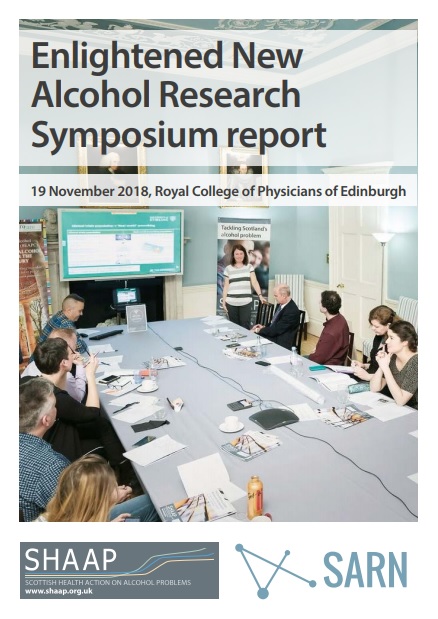SHAAP: Compelling Research Compilation Launched
 Scottish Health Action on Alcohol Problems (SHAAP) and the Scottish Alcohol Research Network (SARN) have published a report covering six presentations at an event held late 2018 in Edinburgh, Scotland.
Scottish Health Action on Alcohol Problems (SHAAP) and the Scottish Alcohol Research Network (SARN) have published a report covering six presentations at an event held late 2018 in Edinburgh, Scotland.
The report covers presentations including:
Alcohol and the Global Burden of Disease: Moving beyond the J-Shaped Curve
Max Griswold explored the much debated research on the association of alcohol on disease and mortality, including a Lancet study re-evaluating the last 30 years of alcohol epidemiological research. Key issues include the lack of precision in the measurement of the volume of alcohol consumed in many of the meta-analyses, resulting in a skewing of results which in some cases made it unclear whether or not alcohol had a harmful or protective effect on certain diseases.
Another issue in previous meta-analyses was problems with standard consumption categories. For example, abstainers were sometimes treated the same as light alcohol users, and in some cases abstainers included both people who had never consumed alcohol with people who used to be heavy alcohol users but now abstained. Further, a key issue over alcohol’s effect on mortality was identified in which many causes of death wholly unrelated to alcohol use were included.
The conclusion, as reported in the Lancet, was that in contrast to the J-curve, even small amounts of alcohol were associated with worsening health outcomes.
The relationship between alcohol, trauma and memory
Ben Butterworth of Glasgow Caledonian University presented on his research on the relationship between post-traumatic alcohol use and traumatic memories, aiming to inform the treatment and prevention of post-traumatic stress disorder (PTSD) and alcohol use. Contextualising trauma, the researcher identified that PTSD leads to victims remembering only selective but striking aspects of incidents, but often being unable to place it in context. Whilst victims of PTSD often report using alcohol in a variety of ways – for example to help them forget trauma, as a coping mechanism, as a numbing effect – many unanswered questions remain for the relationship between alcohol and memory and sufferers of PTSD.
Tackling hazardous alcohol consumption among Ireland’s college students
Susan Calnan, University College Cork, presented on a multi-component pilot programme known as REACT (Responding to Excessive Alcohol Consumption in Third-level) launched in 2015 aimed at reducing hazardous alcohol consumption among college students in Ireland.
Research suggests that up to two-thirds of students show signs of hazardous alcohol consumption and that the gender gap for alcohol consumption is narrowing. So far, findings revealed that two-thirds of students were using alcohol at a harmful level, the majority of whom were not aware that their levels were harmful. Health concerns were low for students, whilst finance issues were more pertinent. Their perceptions of the REACT program itself were positive for the most part, though some questioned the effectiveness of it.
Alcohol marketing and young people in the UK: Where are we at?
Nathan Critchlow, University of Stirling, presented findings based on data from the Youth Alcohol Policy Survey, a cross-sectional survey with 11- 19 year olds in the UK (n=3,399). The findings show that 82% of young people had seen alcohol marketing through at least one channel in the past month and 17% owned alcohol branded merchandise. Marketing awareness was associated with increased alcohol consumption and greater likelihood of higher-risk consumption in current alcohol users.
Critchlow explained marketing extends beyond advertising to four important elements, the Four Ps: Product, Price, Place and Promotion, with advertising as a component of promotion.
A complex and sophisticated network of mass-media advertising, including television, social media, billboards, sponsorships all play a role in a multi-million pound marketing industry.
https://movendi.ngo/science-digest/links-between-alcohol-marketing-and-alcohol-consumption-in-youth/
Seeking women’s views on pregnancy and alcohol
Annie Taylor, Edinburgh Napier University, presented on the rationale and methodology of her ongoing research into women’s experience with alcohol during pregnancy. The researcher identified little research on women’s experience of alcohol use during pregnancy, and virtually none for those who use alcohol at high risk level (35 UK alcohol units per week). Policy tends to focus on preventing Foetal Alcohol Spectrum Disorder (FASD) via promoting alcohol abstention amongst pregnant or women trying to conceive, however evidence suggests that there are varying levels of risk of FASD depending on quantity of alcohol consumed.
Taylor also explained that there are other risk factors for FASD, such as smoking, drug use and low socio-economic status. The research will explore these factors and the gap in understanding around alcohol use.